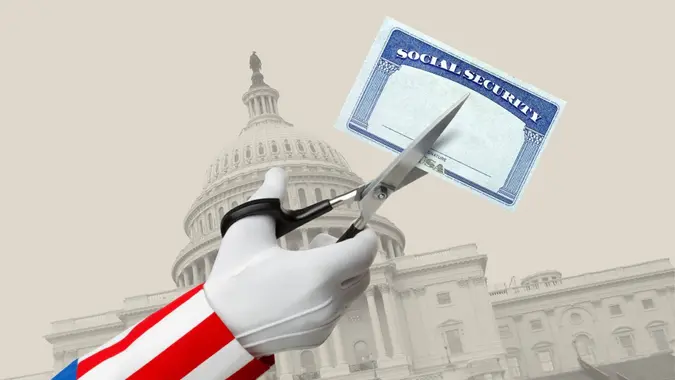The 12 Social Security Proposals You Need To Watch — From Major Cuts to New Benefits

Commitment to Our Readers
GOBankingRates' editorial team is committed to bringing you unbiased reviews and information. We use data-driven methodologies to evaluate financial products and services - our reviews and ratings are not influenced by advertisers. You can read more about our editorial guidelines and our products and services review methodology.

20 Years
Helping You Live Richer

Reviewed
by Experts

Trusted by
Millions of Readers
With the 2024 election season approaching, eyes are on the long-term viability of Social Security. According to the Social Security Administration, around 67 million will receive benefits in 2023. While this number will significantly rise as boomers retire, declining birth rates mean less funding. The Old-Age & Survivors Insurance Trust Fund could run out completely by 2034, leaving 22% to 23% of total benefits unfunded. Yet retirees’ benefit amounts already fail to keep up with inflation and the rising costs of Medicare. These 12 proposals aim to increase funding or alter benefits to help keep the program running.
1. New COLA Calculations
Social Security recipients typically receive annual cost-of-living adjustments (COLAs) that depend on the consumer price index (CPI). One proposal would instead use the “chained” CPI that considers changes in customer buying habits and would lead to smaller adjustments. Alternatively, an elderly index that considers health-related costs could lead to higher increases.
2. Higher Full Retirement Age
While receiving reduced benefits as early as age 62 is possible, the full retirement age depends on your birth year and currently tops out at 67. In response to longer lifespans, two proposals would raise that number every two months until it reaches either 68 or 70.
3. Longevity Indexing
Another proposal calls for using longevity indexing to reduce benefits as the average lifespan increases from one generation to the next. While a higher full retirement age is one option, an alternative is tweaking the benefit formula. All retirees could see smaller benefits with such changes.
4. Higher Payroll Tax Rate
Under current rules, workers and employers each pay 6.2% in Social Security withholding taxes on earnings. One proposal suggests a jump to 7.2% for both parties. Although this would help the program’s viability, you’d feel the higher tax burden during your working years.
5. Higher Payroll Tax Cap
Currently, you pay Social Security taxes on the first $160,200 you earn, and the SSA raises the cap annually. A proposal would raise this cap significantly to cover more wages and help address the funding gap. This would lead to a higher payroll tax burden if you’re a high earner.
6. Payroll Tax Cap Removal
Rather than simply raising the payroll tax cap, a different proposal suggests eliminating it. This would go much further to address the funding gap since the highest earners would need to contribute the current 6.2% on all their wages.
7. Salary Reduction Plan Taxation
Per IRS rules, certain salary reduction plans, such as flexible spending accounts, don’t incur payroll taxes. While this benefits employees, the lack of taxes contributes to the funding gap. This leads some to propose taxing all these plans.
8. Earnings-Based Benefit Reductions
Since your average lifetime earnings affect your Social Security benefits, some proposals target high earners receiving the most. Either the top 25% or 50% of earners could face reduced benefits. However, there are concerns that even middle-class earners could see cuts.
9. Expanded Government Worker Coverage
Some local and state government workers don’t currently contribute to Social Security since they have employer retirement coverage. A proposal would put all new workers in local and state government in the Social Security system. This would allow their retirement contributions to provide needed funding.
10. Longer Average Earnings History
The SSA looks at 35 years of your highest earnings to determine your benefit amount. A proposal raising this to 38 years could help with the funding gap when lower earnings are included. However, this would hurt retirees who get lower payments because of low earnings in those extra years.
11. Means Testing for Benefits
Your savings or other income sources don’t currently affect your ability to receive Social Security benefits. To ensure full benefits for the most needy, one proposal would implement means testing based on income or wealth. And if you exceed the limits set, you’d get reduced Social Security benefits.
12. Higher Benefits for Some Groups
Another Social Security proposal calls for improvements for those who are at a disadvantage. These include providing surviving spouses with higher benefits, offering a minimum benefit amount for everybody and giving earnings credits to caretakers.
More From GOBankingRates
 Written by
Written by  Edited by
Edited by 

























